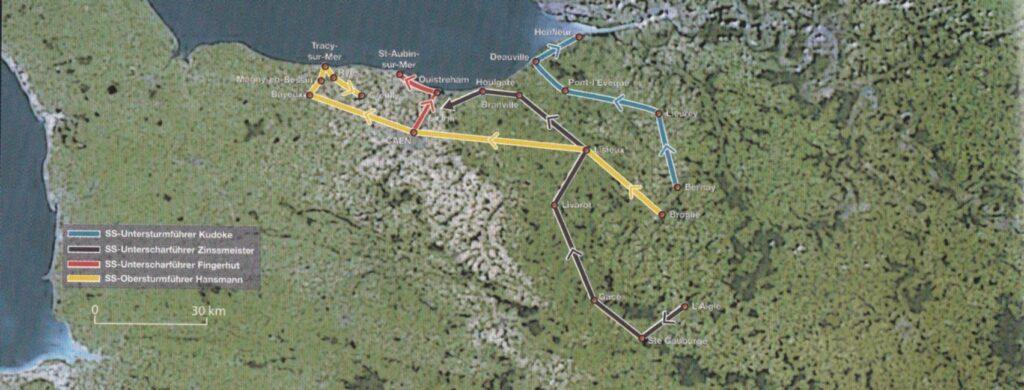Juni 6th, 1944 AA/12 History
The fighting could be heard at the 12th SS Panzer HQ at Chateau le Quesnay (9km west of Pont-l’Eveque/north of Glanville). Orders were received by the 12th SS Panzer Division to establish contact with the 711 Infantry Division and be cautious of airborne landings in their own area.
A reconnaissance element was sent out under the command of Obersturmführer Peter Hansmann, chief of the Division’s Panzerspähkompanie (armored car company). His orders were to report to his commander Sturmbannführer Bremer within 30 minutes with 10x armored reconnaissance vehicles and 2x squads of motorcycle infantry.
Sturmbannführer Bremer split Obersturmführer Hanmann’s men into four scouting parties:
1. Untersturmführer Kudoke – Bernay/Lieurey/Pont l’Eveque & coastal sector Villers sur Mer/Deauville to Honfleur.
2. Unterscharführer Zinbmeister – Lisieux/Branville & coastal sector Houlgate/Dives/Cabourg and east of the mouth of the Orne river.
3. Unterscharführer Fingerhut – Caen area and west of the mouth of the Orne river to Riva-Bella and the coastal sector up to St. Aubin.
4. Obersturmführer Hansmann – Bayeux area and eastern coastal sector to Courseulles.
The four groups were ordered;
a. Report their positions if contact with the enemy was made.
b. Report when their destinations had been reached.
-Note, avoid engaging in fighting and bring back any prisoners immediately.
The four scouting sections departed at 04:00 hours.
Obersturmführer Hansmann departed on his assigned patrol to the Bayeux area, he now has with him 2x eight wheeler armored cars commanded by two veterans of the Russian Campaign, Hans Krapf and Heinz Dahmann.
The route of Obersturmführer Hansmann’s group is described as thus;
“Since our destination was about eighty kilometers away, I chose the fastest route via Broglie, Lisieux to Caen. The knowledge of the roads and towns we had built up during previous exercises and practice reconnaissance drives was now helpful.”
After one hour, we drove through Lisieux…
Since we had another sixty kilometers to our destination, and the coast was approximately forty kilometers to the north, we took the major highway to Caen.
We soon reached Caen. At the entrance to the town there was hectic movement by vehicles of all types. Wehrmacht platoons had taken up positions. A lieutenant asked me where we had come from and whether we had encountered any enemy troops. He was willing to take me to his superior officer who was located a few streets to the north. At the same time, he drew our attention to the noise of fighting. He reported that enemy paratroopers had attacked the Orne bridges approximately ten kilometers to the north and that fighting was still going on. Now, I understood the hectic activity and the massing of infantry at the edge of town. They were Panzergrenadiers of the 21. Pz-Div.
When Obersturmfuhrer Hansmann returned to his men in the armored cars, he discovered that untersturmfuhrer Fingerhut had also arrived with his group from the Panzerspahkompanie. After having briefed his comrade, Obersturmfuhrer Hansmann then sent a situation report to the AA Abteilung.
The patrol then drove through the center of Caen and exits at the west side of town onto the Bayeux road where he found even more traffic congestion and a heavy cloud of smoke drifting in a southeasterly direction, which he understood to be from a successful fighter-bomber attack. He was glad that the straight road to Bayeux is tree lined and the villages along the route were surrounded by wooded areas. Their destination was now just twenty kilometers away.
Upon reaching Bayeux, a German sergeant told Obersturmfuhrer Hansmann that there was heavy fighting going on in the bay of Arromanches and that the English are landing troops from hundreds of ships there. That was the first confirmation that the Obersturmfuhrer has of seaborne landings.
Leaving Bayeux for the coast, Obersturmfuhrer Hansmann stated:
I informed Untersscharfuhrer Dahmann that we would avoid the road from now on and only drive cross country under cover. To the north of the exit of town, the terrain was rising slowly, sparsely covered by farms and pastures. As we were observing and taking turns being in the lead on the drive towards the small village of St. Sulpice; we could see to the left, in the direction of the coast near Tracy, columns of dirt rising into the sky and houses burning. But could not yet see the ocean.
We had to drive another 1,000 meters before we reached the highest spot in the terrain; continued at walking speed, hugging walls of rocks and hedges, we reached the heights, approximately fifty meters, from Magny en Bessin. There we found a farm with trees and a barn. From there, we had a view all across the bay of Arromanches. My armored cars remained on the rear slope, and thanks to the good camouflage which Hans Krapf and Heinz Dahmann had attached at the exit from Bayeux, we looked just like big bushes. From there we could observe the unknown; the improbable, the really unimaginable spectacle!
07:45 hours, bay of Arromanches.
Our own position is three kilometers south of Magny, there were more than 400 ships with a wall of tethered balloons above along the whole coastal strip of thirty kilometers length to the mouth of the Orne in the east. The British are constantly landing troops and heavy equipment without hindrance. We have spotted eleven heavy tanks, the coastal defenses have been eliminated and overrun, infantry of battalion strength is moving south towards Bayeux. The enemy ship’s artillery is firing on Bayeux and the approaches, fighter-bombers are attacking pockets of resistance in the cliffs.
We will continue reconnaissance in the direction of Creully…Out.’

